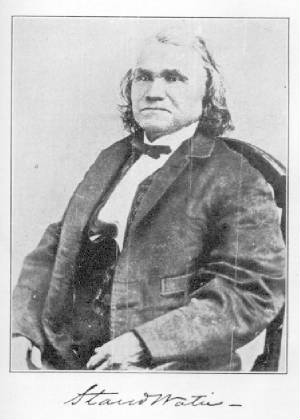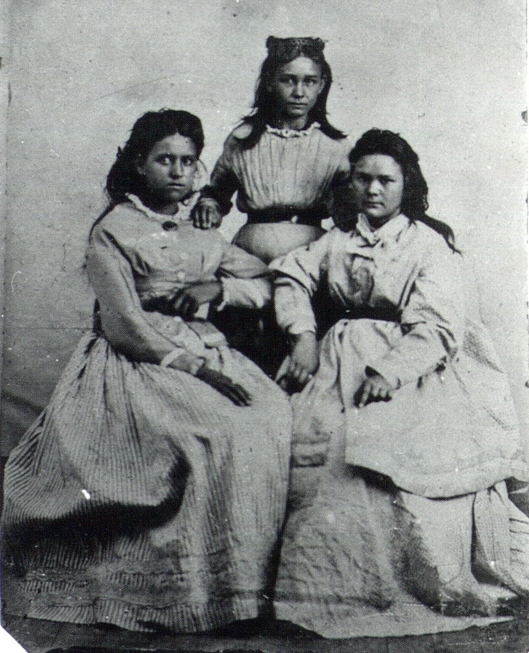|
Stand Watie
| Brigadier General Stand Watie |

|
| National Archives |
Brigadier General Stand Watie, Confederate Army, was commissioned
as a Colonel in the First Cherokee Mounted Rifles in October 1861. Under his command, two regiments and three battalions of
Cherokee, Seminole, and Osage infantry fought throughout Indian Territory, Arkansas, Missouri, Kansas, and Texas, and won
a number of significant battles. In 1865, Stand Watie surrendered to Union forces, the last general in the Confederate Army
to do so.
Born on December 12, 1806, near New Echota in the Cherokee Nation, East,
in present Gordon County, Georgia, Stand Watie was
given the Cherokee name Degadoga, meaning "he stands," at birth. He was a son of a full-blood Cherokee named Oo-wa-tie and
his half-blood wife, Susanna Reese. When Oo-wa-tie was baptized into the Moravian
Church as David Watie, he renamed Degodoga Isaac S. Watie; Watie later
dropped Isaac and combined his Cherokee and Christian names into Stand Watie.
Watie's older brother was named Buck, but he changed his name to Elias
Boudinot. Watie's uncle was the Ridge, who became known as Major Ridge, and his cousin was John Ridge. Together they formed the powerful
Ridge-Watie-Boudinot faction in Cherokee politics.
Watie received his formal education at the Moravian
Mission School at Springplace, Georgia. He remained aloof
from tribal politics until 1836 when he signed the 1835 Treaty of New Echota, by which a group of Cherokees surrendered the ancient Cherokee homeland for a new domain in present Oklahoma. The Ridge-Watie-Boudinot faction migrated to the Cherokee Nation, West, with little
difficulty in March 1837. Watie established his home in the northeastern corner of the Cherokee Nation, along Honey Creek.
| Stand Watie's Daughters |

|
| Daughters of Stand Watie, ca. 1870. |
As a signatory of the removal treaty Watie had forfeited his life under
the Cherokee blood law, which prescribed the death penalty for anyone alienating tribal land. When the penalty was extracted
in June 1839, only Watie among Major Ridge, John Ridge,
and Elias Boudinot escaped execution. Thrust into the forefront of Cherokee politics by the killings, Watie became the lifelong
enemy of Principal Chief of the Cherokee Nation John Ross.
With the onset of the American Civil War Ross wavered in forming a Cherokee-Confederate
alliance. However, Watie accepted a commission as a colonel in the Confederate States Army and raised the First Regiment of
Cherokee Mounted Volunteers. Fearing a coup, Ross reluctantly agreed to a Cherokee-Confederate alliance. However, when the
opportunity arose, Ross fled to Federal-controlled territory. In August 1862, Watie replaced Ross as principal chief.
In spite of early successes, by the winter of 1862-63 the Confederate
hold on the Cherokee Nation was slipping. Nonetheless, Watie's Regiment continued to harass Federal forces. In June and September
1864, Watie scored his greatest military feats in the capture of the Union steamboat J. R. Williams and the Second Battle
of Cabin Creek. In May 1864 Watie was promoted to brigadier general, and in February 1865 he was placed in command of the
Indian Division of Indian Territory. However, by then the war was lost. Watie surrendered on June 23, 1865. He was the last
Confederate general to do so. Afterward, he served as a member of the pro-Southern Cherokee delegation to the Fort Smith Council
in September 1865.
After the Civil War, Watie remained in exile in the Choctaw Nation until
1867. He then returned to Honey Creek to rebuild his home. He died there on September 9, 1871. He was buried in the old Ridge Cemetery, later called Polson's Cemetery, in Delaware County, Oklahoma.
Stand Watie had four wives Eleanor Looney, Elizabeth
Fields, Isabella Hicks, and Sarah Caroline Bell. Elizabeth Fields's and Watie's child died during childbirth in 1836. He married
Sarah Caroline Bell in 1842. They had three sons and two daughters. All died without issue.
BIBLIOGRAPHY: Edward E.
Dale and Gaston Litton, ed., Cherokee Cavaliers: Forty Years of Cherokee History as Told in the Correspondence of the Ridge-Watie-Boudinot
Family (Norman: University of Oklahoma Press, 1939). Kenny A. Franks, Stand Watie and the Agony of the Cherokee Nation
(Memphis, Tenn.: Memphis State University Press, 1979). Morris L. Wardell,
A Political History of the Cherokee Nation, 1838-1907 (Norman: University of Oklahoma Press, 1938). Grace Steele Woodward,
The Cherokees (Norman: University of Oklahoma Press, 1963). Kenny A. Franks, © Oklahoma Historical Society; photo Stand
Watie courtesy National Archives; photo of daughters: Image #16978 in the Stand Watie Collection.
Recommended Reading:
Rifles for Watie. Description: This is a rich and sweeping novel-rich in its panorama of history; in its details so clear that the
reader never doubts for a moment that he is there; in its dozens of different people, each one fully realized and wholly recognizable.
It is a story of a lesser -- known part of the Civil War, the Western campaign, a part different in its issues and its problems,
and fought with a different savagery. Inexorably it moves to a dramatic climax, evoking a brilliant picture of a war and the
men of both sides who fought in it.
Recommended Reading: General
Stand Watie's Confederate Indians (University of Oklahoma Press). Description: American Indians were
courted by both the North and the South prior to that great and horrific conflict known as the American Civil War. This is
the story of the highest ranking Native American--Cherokee chief and Confederate general--Stand Watie, his Cherokee
Fighting Unit, the Cherokee, and the conflict in the West...
Recommended
Reading: The Cherokee Nation in the Civil War
(Hardcover). Description: This book offers a broad overview of the war as it affected the Cherokees--a social history of a
people plunged into crisis. The Cherokee Nation in the Civil War shows how the Cherokee people, who had only just begun to
recover from the ordeal of removal, faced an equally devastating upheaval in the Civil War. Clarissa W. Confer illustrates
how the Cherokee Nation, with its sovereign status and distinct culture, had a wartime experience unlike that of any other
group of people--and suffered perhaps the greatest losses of land, population, and sovereignty. Continued below…
No one questions
the horrific impact of the Civil War on America,
but few realize its effect on American Indians. Residents of Indian Territory
found the war especially devastating. Their homeland was beset not only by regular army operations but also by guerrillas
and bushwhackers. Complicating the situation even further, Cherokee men fought for the Union
as well as the Confederacy and created their own "brothers' war." About the Author: Clarissa W. Confer is Assistant Professor
of History at California University of Pennsylvania.
Highly Recommended Viewing: Indian Warriors - The Untold Story of the Civil War (History Channel) (2007). Description: Though largely forgotten, 20 to 30 thousand Native Americans fought in the Civil War.
Ely Parker was a Seneca leader who found himself in the thick of battle under the command of General Ulysses S. Grant. Stand Waite, a Confederate General and a Cherokee, was known for his brilliant guerrilla tactics. Continued...
Also highlighted is Henry Berry Lowery, an Eastern North Carolina Indian, who became known as the
Robin Hood of North Carolina. Respected Civil War authors, Thom Hatch and Lawrence Hauptman, help reconstruct these most captivating
stories, along with descendants like Cherokee Nation member Jay Hanna, whose great-grandfathers fought for both the Union and the Confederacy.
Together, they reveal a new, fresh perspective and the very personal reasons that drew these Native Americans into the fray.
Also consider:
Civil War Terror (History Channel) Description:
This is the largely untold story of a war waged by secret agents and spies on both sides of the Mason Dixon Line. These are
tales of hidden conspiracies of terror that specifically targeted the civilian populations. Engineers of chemical weapons,
new-fangled explosives and biological warfare competed to topple their enemy. With insight from Civil War authorities, we
debunk the long-held image of a romantic and gentlemanly war. To revisit the past, we incorporate written sources, archival
photographs and newspaper headlines. Our reenactments bring to life key moments in our historical characters' lives and in
each of the horrific terrorist plots.
General Stand Watie History, Confederate Colonel Stand Watie, Chief Stand Watie Pictures, Cherokee Chief Stand Watie,
1st First Cherokee Mounted Rifles, 2nd Second Cherokee Mounted Rifles Battles History
|

